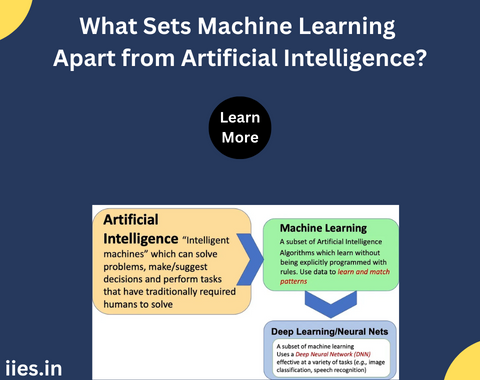Narrow AI is designed for specific tasks, excelling in a predefined domain but lacking the ability to generalize across different domains. On the other hand, General AI exhibits human-like intelligence across a wide range of tasks, possessing the ability to adapt and learn in various situations. As of now, General AI remains more of a theoretical concept, with Narrow AI dominating the current technological landscape.
Enter Machine Learning
Machine Learning, a subset of Artificial Intelligence, focuses on the development of algorithms that enable machines to learn from data and improve their performance over time without explicit programming. Instead of being explicitly programmed to perform a task, ML systems learn from patterns and experiences, allowing them to make data-driven predictions or decisions. This learning process is characterized by the system’s ability to iteratively improve its performance as it is exposed to more data.
One key differentiator between AI and ML is the learning aspect. AI encompasses a broader range of capabilities, including rule-based systems and expert systems that do not necessarily involve learning from data. In contrast, ML is centered around the idea of leveraging data to enhance the system’s performance and make more informed decisions.
The Role of Data in Machine Learning
At the heart of machine learning lies the crucial role of data. ML algorithms rely on large datasets to identify patterns, correlations, and trends that enable the system to make accurate predictions or classifications. This data-driven approach allows ML models to adapt to changing scenarios and improve their accuracy over time.
Supervised learning, unsupervised learning, and reinforcement learning are three primary paradigms within machine learning. Unsupervised learning, on the other hand, deals with unlabeled data, seeking to identify patterns and relationships within the dataset. Reinforcement learning involves training a model through a system of rewards and punishments, allowing the algorithm to learn optimal behavior through trial and error.
The Dynamic Nature of Machine Learning
One of the distinctive features of machine learning is its dynamic nature. ML models can adapt to new information and evolving datasets, making them highly flexible and versatile. This adaptability is particularly valuable in domains where the underlying patterns and relationships are subject to change, such as in financial markets, healthcare, and natural language processing.
Contrastingly, traditional AI systems often rely on static rule-based programming, making them less capable of adapting to unforeseen circumstances. Machine learning’s ability to evolve with new data is a key factor driving its widespread adoption in various industries, from recommendation systems in e-commerce to predictive maintenance in manufacturing.
Real-world Applications of Machine Learning
The practical applications of machine learning are diverse and continually expanding. In healthcare, ML is employed for disease diagnosis, personalized treatment plans, and drug discovery. Financial institutions leverage ML algorithms for fraud detection, credit scoring, and algorithmic trading. In the realm of autonomous vehicles, machine learning plays a pivotal role in enhancing navigation systems, object recognition, and decision-making processes.
Moreover, natural language processing (NLP) applications, such as virtual assistants and language translation, heavily rely on machine learning algorithms. Image and speech recognition technologies also benefit from ML, enabling advancements in facial recognition, voice assistants, and image classification.
Understanding Artificial Intelligence Beyond Machine Learning
While machine learning represents a significant aspect of artificial intelligence, it is essential to recognize that AI encompasses more than just learning from data. Rule-based systems, expert systems, and symbolic AI are examples of AI approaches that do not necessarily involve machine learning. These systems operate based on predefined rules and knowledge, relying on logical reasoning rather than learning from experience.
Symbolic AI, for instance, involves encoding human knowledge and reasoning into a set of rules and symbols. This approach aims to emulate human-like intelligence by representing knowledge explicitly, enabling the system to perform complex tasks. In contrast to machine learning’s data-driven approach, symbolic AI relies on explicit programming and knowledge representation.

